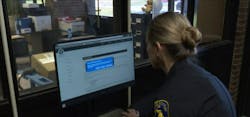Time is a limited resource for law enforcement officers on the street, and new technology can help assist agencies in finding ways to increase both efficiency and safety. Lexis Nexis Coplogic Solutions’ suite of crash reporting tools can help eliminate time-consuming processes and improve report accuracy with automated incident and crash reporting. OFFICER Magazine recently spoke to Lansing, Michigan, Police Capt. Katherine Diehl about how the agency uses the software to support officers on patrol.
This article appeared in the September/October issue of OFFICER Magazine. Click Here to subscribe to OFFICER Magazine.
When the Lansing Police Department first implemented the solution 12 years ago, it became the first in the state to switch to electronic citation and crash collection. Previously, officers used pen and paper to complete the reports and would have to stand on the side of the road to write down the information. The new software gave the agency the ability to swipe the driver’s license and collect all of the information and populate it automatically into the crash report.An evolving tool
Diehl says that the use of Coplogic Solutions has been a huge success for the Lansing Police Department. “Anytime we can save time for our police officers—especially throughout the years as budget costs have dwindled a little bit and our officer resources have grown because we’re just not staffed as heavily as we used to be.”
As time has passed, the software itself has evolved, making it an even stronger asset for agencies. “Just the ability to have it online at our fingertips and on our computers and in our cars. You run the license, you run the license plate and you drop and drag that. As the state mandates have changed, so does Coplogic and they change their forms as well. It just keeps getting better and better.”
She says that Coplogic also has allowed the department the ability to supplement on scene reports. The agency just recently launched online crash reporting to be used by civilians. “I was pushing for this for the last couple years. On minor crash reports that are happening where officers can’t get there in time, for the people involved, it’s a time saver. They don’t have to wait 45 minutes or an hour for an officer to come out there when they can just go online and report these minor accidents, and then we can call them later and follow up if we need to.”
So far, the reviews on the online crash reporting have been great, according to Diehl. “Just from our citizens not having to wait an hour for an officer to come take a report,” she says. “We have that online and you can access it from your phone or go home and pull it up on your computer.”Training involved for officers
While it’s no secret that officers tend to hate change, Diehl says that pushback to using the software and updated features is something she doesn’t believe is even a consideration now with the new generations moving into the ranks. “Obviously, they’re more tech savvy. They want the latest and greatest in technology,” she says. “Again, it’s another system that we have to log into and another password, so you do hear some grumblings about things like that, however, it’s more of an inconvenience if our computers aren’t working.”
Coplogic allows officers to drag and drop data into a report with the swipe of a license. From there, they can modify the diagram and get creative, going into more depth into what that crash looked like. “I truly do believe that if we don’t have the computers or CopLogic isn’t working—which is very rare—it’s more of an inconvenience for us,” she says. “This has really been an easy transition for all of our officers.”
The ability for officers and citizens to get out of the roadway quickly has been welcomed by the agency. “It’s saving a lot of time and resources,” she says, adding that a lot of the progress can be attributed to Lansing’s former police chief, Mike Yankowski. “He was really into the data-driven approaches and he really spearheaded a lot of this. We had CopLogic before Chief Yankowski, but this was a priority for him and it’s remained a priority for us.”
Using data to increase traffic safety
The Lansing Police Department has always been proactive when it comes to employing a data-driven approach to crime and traffic safety. “We look at how many intersections we have in the in the city and we focus our time and efforts on those specific areas. Then we see if what we are doing is getting the job done.” Lansing can take that data to the Michigan Department of Transportation and see if the speed limit can be lowered or if more signage is needed.
Just recently, the city purchased 25 speed signs that are movable within the city to focus on problem areas. “We use that traffic data, whether it’s the crash data or the citation data, and we can move those speed signs throughout the city to see where maybe what areas are we seeing these speeders at? Where are we writing more of these speeding citations? Then we can move them as a deterrent for speed,” says Diehl. “So, we’re pretty lucky to have that ability with those resources, but the data kind of dictates sometimes where we’re going to focus our efforts.” She says the in the end, the goal is for the citizens and officers to be safer, and Coplogic helps them do that. “We want our drivers to be safe. We want our citizens to be safe, our pedestrian traffic to be safe, so we use that to keep a focus on those areas. It’s also an asset to our community. When our community reaches out to us and say, ‘Hey, we think we’re having a speeding problem here,’ we can go to the data. What is the data telling us? We can go back to the community when they have complaints and concerns, and we can say ‘Well, we’ve been doing this for a long time. We could show you these trends.’ We do get this a lot where they may think that there’s a lot of speeders or running the stop signs and then we can go back to them and say ‘We’ve only written this many tickets’ or had to respond to this many traffic crashes in this intersection, and then you look at the trends in general and say, ‘Well, if you go back five years, look how these have decreased.’ ”
About the Author
Paul Peluso
Editor
Paul Peluso is the Managing Editor of OFFICER Magazine and has been with the Officer Media Group since 2006. He began as an Associate Editor, writing and editing content for Officer.com. Previously, Paul worked as a reporter for several newspapers in the suburbs of Baltimore, MD.



